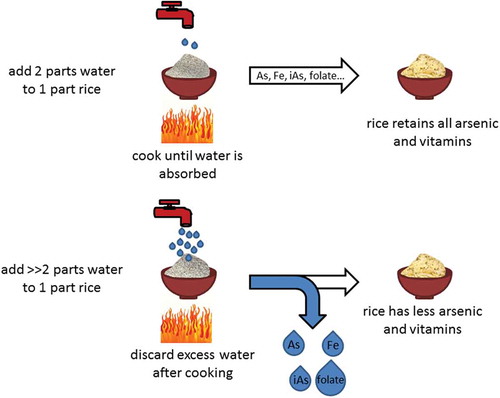Le riz est la céréale le plus riche en arsenic (10 fois plus que les autres). Le riz complet est 10 à 20 fois plus riche que le riz blanc
(n'oublions pas que le riz, c'est le secret des sumo pour prendre rapidement du poids et du ventre)
Inorganic arsenic in rice bran and its products are an order of magnitude higher than in bulk grain.
Environ Sci Technol. 2008 Oct 1;42(19):7542-6. Sun GX
Rice is more elevated in arsenic than all other grain crops tested to date, with whole grain (brown) rice having higher arsenic levels than polished (white). It is reported here that rice bran, both commercially purchased and specifically milled for this study, have levels of inorganic arsenic, a nonthreshold, class 1 carcinogen, reaching concentrations of approximately 1 mg/kg dry weight, around 10-20 fold higher than concentrations found in bulk grain. Although pure rice bran is used as a health food supplement, perhaps of more concern is rice bran solubles, which are marketed as a superfood and as a supplement to malnourished children in international aid programs. Five rice bran solubles products were tested, sourced from the United States and Japan, and were found to have 0.61-1.9 mg/kg inorganic arsenic. Manufactures recommend approximately 20 g servings of the rice bran solubles per day, which equates to a 0.012-0.038 mg intake of inorganic arsenic. There are no maximum concentration levels (MCLs) set for arsenic or its species in food stuffs. EU and U.S. water regulations, set at 0.01 mg/L total or inorganic arsenic, respectively, are based on the assumption that 1 L of water per day is consumed, i.e., 0.01 mg of arsenic/ day. At the manufacturers recommended rice bran solubles consumption rate, inorganic arsenic intake exceeds 0.01 mg/ day, remembering that rice bran solubles are targeted at malnourished children and that actual risk is based on mg kg(-1) day(-1) intake.
Avec les cuiseur de riz dans lesquels ont met peu d'eau, on est exposé à 100% de l'arsenic. En rinçant à fond son riz cuit, on retire la moitié de l'arsenic. En cuisant avec un percolateur on en retire aussi 50%
Rethinking Rice Preparation for Highly Efficient Removal of Inorganic Arsenic Using Percolating Cooking Water
Manus Carey PLOS Published: July 22, 2015
A novel way of cooking rice to maximize the removal of the carcinogen inorganic arsenic (Asi) is presented here. In conventional rice cooking water and grain are in continuous contact, and it is known that the larger the water:rice cooking ratio, the more Asi removed by cooking, suggesting that the Asi in the grain is mobile in water. Experiments were designed where rice is cooked in a continual stream of percolating near boiling water, either low in Asi, or Asi free. This has the advantage of not only exposing grain to large volumes of cooking water, but also physically removes any Asi leached from the grain into the water receiving vessel. The relationship between cooking water volume and Asi removal in conventional rice cooking was demonstrated for the rice types under study. At a water-to-rice cooking ratio of 12:1, 57±5% of Asi could be removed, average of 6 wholegrain and 6 polished rice samples. Two types of percolating technology were tested, one where the cooking water was recycled through condensing boiling water steam and passing the freshly distilled hot water through the grain in a laboratory setting, and one where tap water was used to cook the rice held in an off-the-shelf coffee percolator in a domestic setting. Both approaches proved highly effective in removing Asi from the cooking rice, with up to 85% of Asi removed from individual rice types. For the recycled water experiment 59±8% and 69±10% of Asi was removed, on average, compared to uncooked rice for polished (n=27) and wholegrain (n=13) rice, respectively. For coffee percolation there was no difference between wholegrain and polished rice, and the effectiveness of Asi removal was 49±7% across 6 wholegrain and 6 polished rice samples. The manuscript explores the potential applications and further optimization of this percolating cooking water, high Asi removal, discovery.














